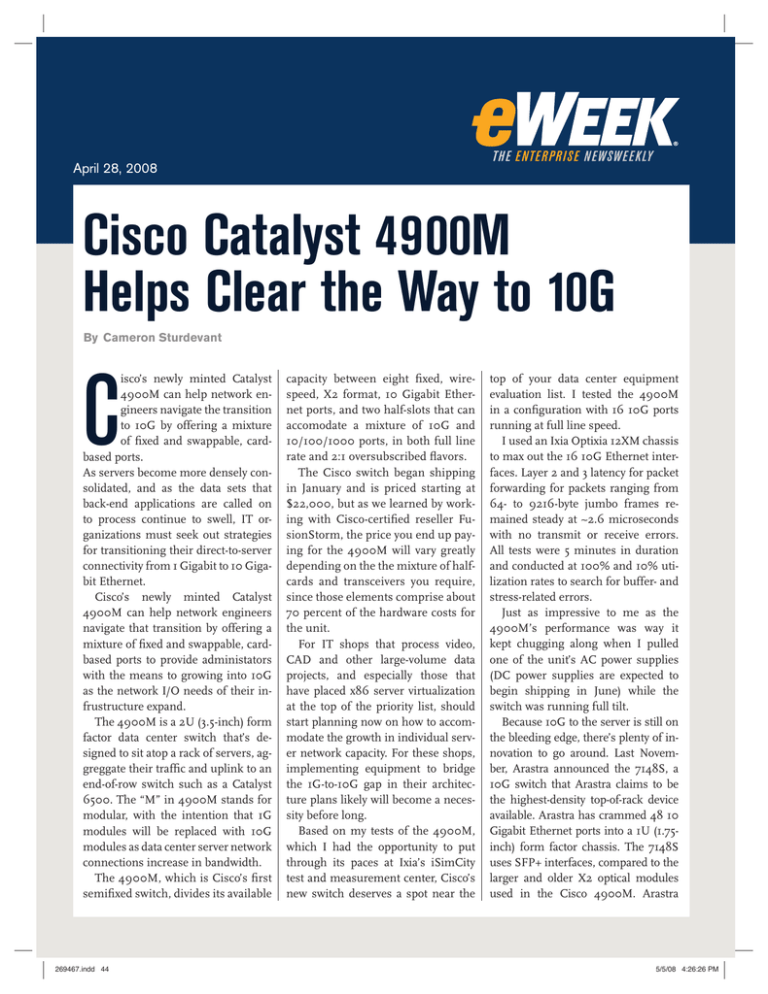
April 28, 2008
Cisco Catalyst 4900M
Helps Clear the Way to 10G
By Cameron Sturdevant
isco’s newly minted Catalyst
4900M can help network engineers navigate the transition
to 10G by offering a mixture
of fixed and swappable, cardbased ports.
As servers become more densely consolidated, and as the data sets that
back-end applications are called on
to process continue to swell, IT organizations must seek out strategies
for transitioning their direct-to-server
connectivity from 1 Gigabit to 10 Gigabit Ethernet.
Cisco’s newly minted Catalyst
4900M can help network engineers
navigate that transition by offering a
mixture of fixed and swappable, cardbased ports to provide administators
with the means to growing into 10G
as the network I/O needs of their infrustructure expand.
The 4900M is a 2U (3.5-inch) form
factor data center switch that’s designed to sit atop a rack of servers, aggreggate their traffic and uplink to an
end-of-row switch such as a Catalyst
6500. The “M” in 4900M stands for
modular, with the intention that 1G
modules will be replaced with 10G
modules as data center server network
connections increase in bandwidth.
The 4900M, which is Cisco’s first
semifixed switch, divides its available
C
269467.indd 44
capacity between eight fixed, wirespeed, X2 format, 10 Gigabit Ethernet ports, and two half-slots that can
accomodate a mixture of 10G and
10/100/1000 ports, in both full line
rate and 2:1 oversubscribed flavors.
The Cisco switch began shipping
in January and is priced starting at
$22,000, but as we learned by working with Cisco-certified reseller FusionStorm, the price you end up paying for the 4900M will vary greatly
depending on the the mixture of halfcards and transceivers you require,
since those elements comprise about
70 percent of the hardware costs for
the unit.
For IT shops that process video,
CAD and other large-volume data
projects, and especially those that
have placed x86 server virtualization
at the top of the priority list, should
start planning now on how to accommodate the growth in individual server network capacity. For these shops,
implementing equipment to bridge
the 1G-to-10G gap in their architecture plans likely will become a necessity before long.
Based on my tests of the 4900M,
which I had the opportunity to put
through its paces at Ixia’s iSimCity
test and measurement center, Cisco’s
new switch deserves a spot near the
top of your data center equipment
evaluation list. I tested the 4900M
in a configuration with 16 10G ports
running at full line speed.
I used an Ixia Optixia 12XM chassis
to max out the 16 10G Ethernet interfaces. Layer 2 and 3 latency for packet
forwarding for packets ranging from
64- to 9216-byte jumbo frames remained steady at ~2.6 microseconds
with no transmit or receive errors.
All tests were 5 minutes in duration
and conducted at 100% and 10% utilization rates to search for buffer- and
stress-related errors.
Just as impressive to me as the
4900M’s performance was way it
kept chugging along when I pulled
one of the unit’s AC power supplies
(DC power supplies are expected to
begin shipping in June) while the
switch was running full tilt.
Because 10G to the server is still on
the bleeding edge, there’s plenty of innovation to go around. Last November, Arastra announced the 7148S, a
10G switch that Arastra claims to be
the highest-density top-of-rack device
available. Arastra has crammed 48 10
Gigabit Ethernet ports into a 1U (1.75inch) form factor chassis. The 7148S
uses SFP+ interfaces, compared to the
larger and older X2 optical modules
used in the Cisco 4900M. Arastra
5/5/08 4:26:26 PM
wouldn’t disclose pricing but claims
to be holding to a target price per port
that is only two to three times the cost
of a 1G port.
Networks in transition
The 4900M design and function is
all about supporting a transition from
1G to 10G Ethernet in top-of-rack data
center installations. Based on my tests
with the 4900M, it’s easy to see how
this field-upgradeable unit will fit the
transition bill.
There are three different half-cards
available for the 4900M’s two slots, a
20-port wire-speed 10/100/1000 RJ45, a four-port wire-speed 10 Gigabit
Ethernet X2, and an eight-port 2-to-1
oversubscribed 10 Gigabit Ethernet
X2 card. What’s more, the 2-to-1 oversubscribed card can accomodate Cisco
TwinGig converter optic modules to
provide up to 16 1G ports. This neardizzying array of configuration choices
boils down to enough flexibility to accommodate almost any transition plan
for servers that need to move from 1G
to 10G network connectivity.
However, with the flexibility that
this semifixed switch can provide
comes added management responsibility. The capacity and function of a
4900M will vary broady depending on
the mixture of cards in place. For example, the maximum number of available ports could go from 46 (with two
10/100/1000 half-cards providing 40
1G ports, six available fixed 10G ports,
and two uplinks for an end-of-row aggregation switch) to 14 (14 10G ports,
again with two 10G uplinks).
I was able to use the Cisco IOS interface to keep track of which cards
were deployed in my system without
much trouble, but I found it invaluable to have a Cisco engineer at my
disposal to assist in device configuration and setup. The show commands
that are familiar to any Cisco-certified
technician make it easy to see which
cards are installed in the chassis.
Since most transitions to 10G will
likely occur in a fairly predictable swell
as opposed to an overnight mandate, I
see keeping track of where the variously configured half-cards are deployed
as a management cost that must be
factored in to the cost of deploying
the 4900M in any data center. Senior
network architects at your organization must pay heed to these inventory
issues and ensure that half-cards are
deployed in an efficient manner.
The half-card modules, power supplies and fan tray are all field-serviceable components and require only a
screwdriver access. There is a CompactFlash slot for field-service switch image
upgrades and two USB ports that also
can be used to make a direct connection
to the 4900M for field servicing if necessary. In addition, the 4900M has the
usual console port along with a 1G NIC
that can be connected to a management
network for out-of-band management
of the device.
eWEEK Labs Technical Director Cameron
Sturdevant can be reached at csturdevant@
eweek.com, or at his blog, here.
Reprinted from eWEEK, April 28, 2008 with permission from Ziff Davis Enterprise Inc.
©2008 Ziff Davis Enterprise Holdings Inc. All rights reserved.
269467.indd 45
5/5/08 4:26:26 PM




